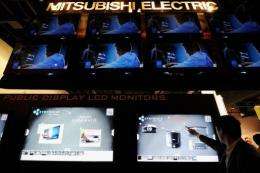User interface revolution coming to computers, TVs

Control your television with your voice or a wave of the hand. Run your laptop with your eyes.
New user interface technologies on display at the Consumer Electronics Show (CES) in Las Vegas are making a world without buttons, keyboards or even touchscreens a reality.
"These days devices get smarter and smarter," said Derek Li, president and chief executive of Zienon, a Chicago company which develops touch-free input technology.
But interfaces have not kept up. "It is like the personal computers in the 1980s that had only keyboards and no mouse," said Li, whose AirMove technology allows users to control electronic devices by waving a hand in the air.
"Control is going to be more intuitive," he predicted. "You are going to be using your hands to directly control your TV interface.
"Nobody wants to have to find their remote for something as simple as changing channels," he added.
Kinect, Microsoft's voice and gesture recognition accessory for the Xbox 360 game console, deserves much of the credit for demonstrating the capabilities of hands-free control to the general public.
More than 18 million Kinects have been sold in just a little over a year, and its success has given a boost to researchers working on new interfaces between people and their machines.

"If Kinect had been a flop it would have taken years to get over it," said Virgile Delporte, vice president of marketing for SoftKinetic, a Belgian company which has developed gesture recognition technology.
"The first usage was for play," Delporte said, but gesture recognition can be applied to medicine, sports rehabilitation and many other areas.
"This has wide implications for a lot of industries, like doctors in operating rooms being able to control equipment without touching it," Zienon's Li said.
"Eventually it's going to end up on laptops and tablets," Delporte said, with uses that cannot even be imagined yet.
Microsoft chief executive Steve Ballmer announced Monday in his opening CES keynote address that the US software giant plans to bring Kinect technology to Windows personal computers next month.

Another cutting-edge technology which could also end up on computers soon is eye tracking and eye control, which has been pioneered by the Swedish company Tobii Technology.
Tobii is displaying its eye tracking technology at CES with what it calls the world's first "eye controlled laptop" and the first "eye controlled arcade game," in which a player destroys asteroids just by looking at them.
If you don't feel like waving your hand at your television you can always talk to it.
Massachusetts-based startup Vlingo is promising to bring voice-controlled "virtual assistants" -- like Siri on Apple's latest iPhone -- to TV sets.
"If you are sitting on your couch you can just use your voice to control your TV, set-top box, cable-box or whatever," Vlingo's Chris Barnett told AFP.
"The TV will talk back to you in virtual assistant mode, ask what you want to see and drill down into what you are looking for," he said.
Viewers could ask assistants to find shows with particular actors or in preferred genres, or tell televisions to record or rent specific films or programs.
Microphones will be built into televisions or, more likely, remote controls, to let Vlingo software listen to viewers, according to Barnett.
"The Vlingo virtual assistant for TV is designed to modernize that thing your grandfather once called a 'remote control,'" he said.
(c) 2012 AFP





















